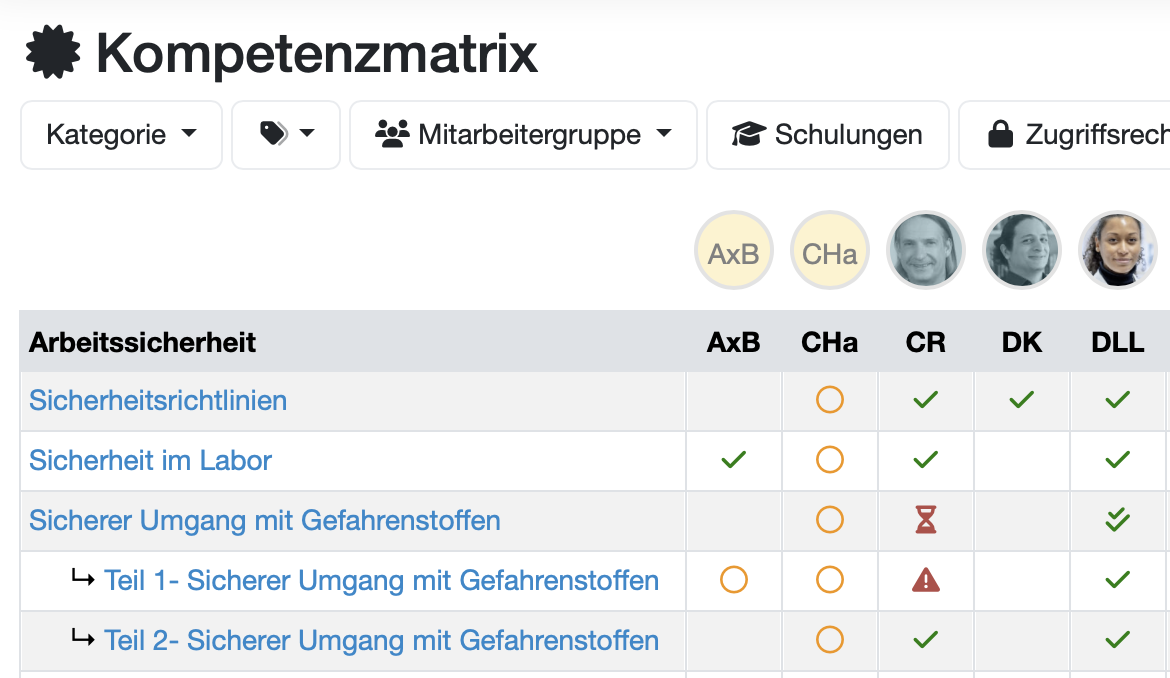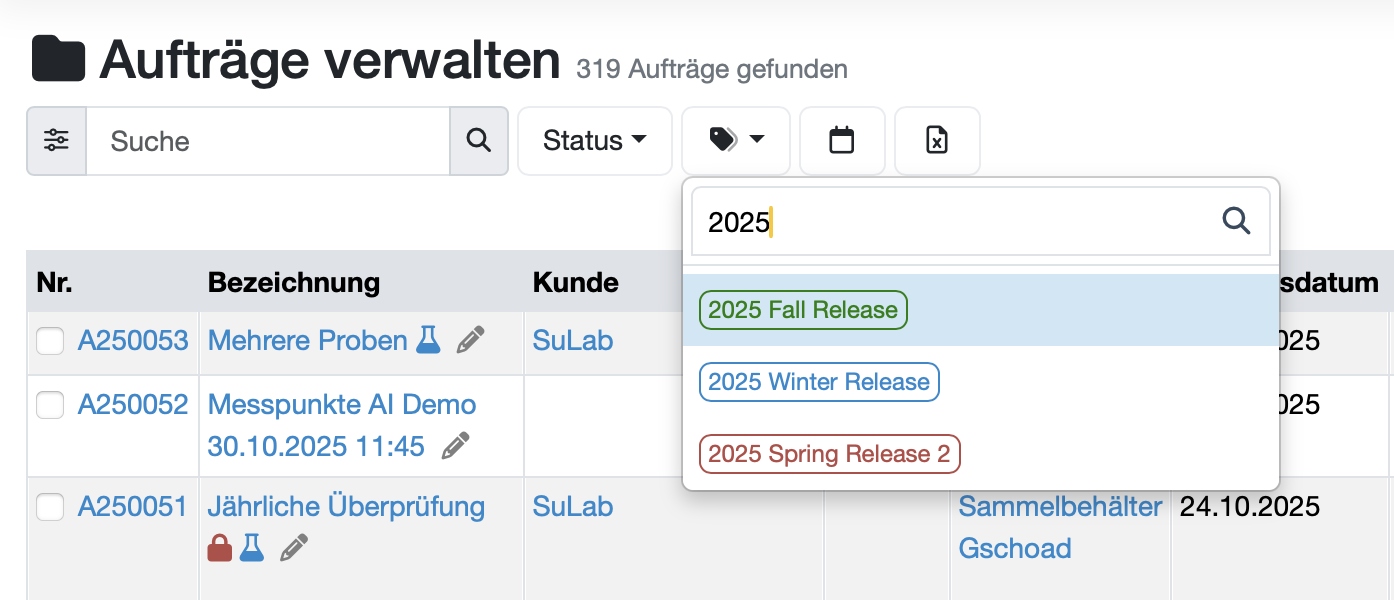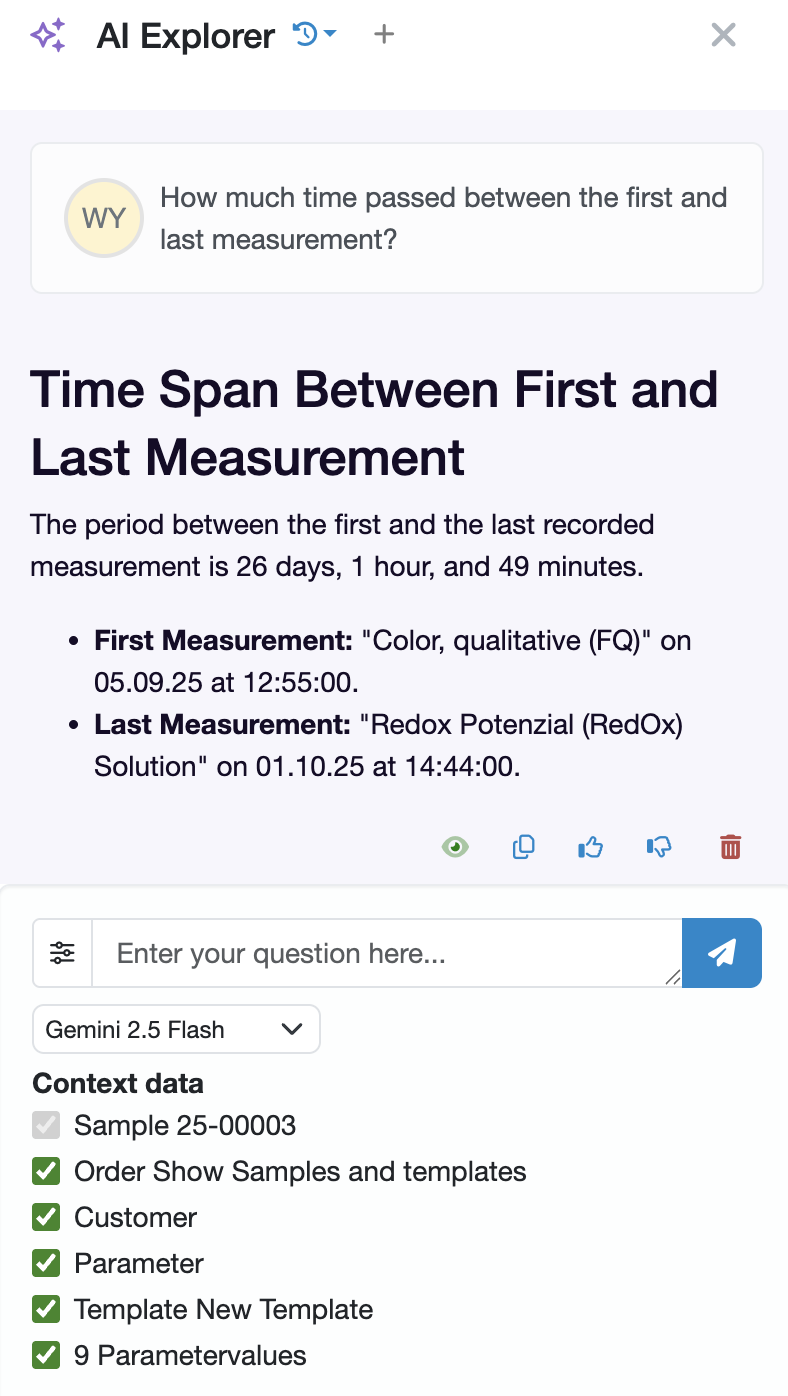Labordatenbank version directory
A description of the latest general enhancements / changes / corrections to the Labordatenbank.
2025 Winter Release
11/24/25Query Explorer
With the Query Explorer, users can formulate questions in natural language.
The AI automatically generates the appropriate SQL query, the result of which can be
and can be expanded as required. Useful queries can be saved as an evaluation or integrated into the dashboard.
Weitere AI-Modelle
The AI model "Mistral" has been added as an AI alternative from Europe and can be selected in the laboratory database.
Competence matrix
Based on DIN EN ISO/IEC 17025, the qualification matrix has been renamed the competence matrix and some functions have been added:
- For a competence, it is possible to create sub-competences that must be fulfilled in order to obtain a competence.
- Competencies and sub-competencies can be linked directly to training courses and documents. This makes it possible to obtain a competence by participating in a training course or by reading a document.
- Missing competences can also be displayed in the competence matrix.
Customer zone
The evaluation view in the customer zone is a full view. This allows you to provide your customers with comprehensive evaluations with search and filter options and integrated diagrams.
Updated sub-navigation bar
- The view of the sub-navigation bar has been updated and standardized for all data types.
- In addition, searchable drop-down fields have been implemented for all filters, allowing you to search consistently and more easily.
Import interfaces
- A new import interface type for notes has been added.
- The customer, contact, invoice and sample master data import interfaces have been changed to the new universal import interface to standardize the audit trail and enable validation of the import interface with the next update.
Reports
To support long-term archiving and long-term readability, a conversion to the ISO standard format PDF/A-3b (a format for long-term archiving of electronic documents) was carried out.
Further new features with this update
- It is possible to create tasks for evaluations and processes.
- The creator is no longer automatically included in the access rights selection (the "and I" has been removed).
- Signatures with a digital certificate can be freely placed in the document control.
- Recipes are available in the quick search.
- SFTP authentication for import and export interfaces (evaluations) is now also possible with an SSH key.
- Billing items of an order can be suggested with SQL evaluations.
- An evaluation trigger for gauge control value entries has been implemented.
- Default entries for CC and BCC can be stored for quotations in the system settings.
- Keywords and statuses have been implemented for sample and order templates.
- The sort order of the ELN can be reversed.
- Years can also be selected for scheduled orders.
- In addition, several performance improvements have been implemented.
In our community call on Fri. 21.11.25 we will personally present the points listed.
Risk Assessment
An interdisciplinary team of four identified and assessed a total of 15 risks for all feature developments in this release. Of these, 13 were classified as low risk and 2 as medium risk by calculating a risk priority number.
The two medium risks from the risk assessment report include
1.) The risk that realistic-looking but incorrect answers from Query Explorer are simply adopted by the customer (e.g. deleted
(e.g. deleted samples are unconsciously included). Here we would like to point out once again that answers generated by AI models can always contain errors.
- The risk that existing import interfaces of the data type customers, contacts, invoices or sample master data no longer function as usual due to the changeover to the universal interface. We have minimized this risk internally through extensive integration and acceptance tests. However, there is a clear recommendation to carry out tests for your import interfaces for the above-mentioned data types.
2025 Fall Release
09/08/25The laboratory database now offers an integrated AI Explorer that allows you to analyze and evaluate all data in the laboratory database using artificial intelligence (AI). The AI module can be activated via the system settings. To do this, access rights must be enabled for selected users.
Important note: AI Explorer answers may contain errors. Please check the answers.
AI Imports
An AI model can now be configured for the import interfaces, whereby an unstructured data set can be brought into a clearly defined laboratory database structure and reliably imported into the laboratory database data structure.
In addition, the import interfaces have been converted to the Universal Importer. This change improves the consistency and maintainability of the import functions.
Improvements to import transformation codes
The ID of the imported datakey is now included in the response for imports, which makes it easier to track import processes.
Quick search
The quick search has been expanded to include the following areas:
Projects: Projects can now be found directly via the quick search as well as 8D reports, assets and processes.
Automatic selection: Search results with only one hit are automatically selected.
Test Framework Update
Automated browser tests have been added to our integrated test framework to enable higher test coverage.
Database setting
Unixtime stamps and foreign keys have been changed from int to unsigned int.
Risk Assessment
In the course of the risk assessment, 8 low risks were identified.
The following important notes result from the risk assessment:
Existing import interfaces should be tested after the update to ensure correct functionality. We would also like to explicitly point out once again that all AI Explorer results must be carefully checked before further processing.
2025 Summer Release
05/21/25Tasks with comment function
Comments can now be added to tasks. When commenting on a task, the associated employees are notified by e-mail and can reply directly by e-mail. The reply is also attached to the task as a comment. Once a task has been completed, all participants receive an e-mail notification.

Employees
For newly created employees and customer contacts with activated login, the users receive an e-mail to set their password (this forces a password change). For existing employees or contacts, a password reset can be requested by clicking on a "Password reset" button.
Evaluations
The PDFs generated with the laboratory database (reports, invoices, offers, worksheets) can now be included in evaluations with SFTP uploads (as previously with automated e-mail dispatch).

Status management
Conditions for status changes can now be stored in the form of SQL rules. For example, it can be set that a sample can only be released if all values have been entered or that a test equipment is only released after a calibration has been performed.
System settings
The IP addresses used by the Cloud laboratory database are now displayed in the system settings (the Cloud laboratory database has one IP address per availability zone).
Quotes & Invoices
Notes can now be stored and commented on quotations and invoices. For example, an order can be stored directly as a PDF file with the quotation.
Furthermore, item numbers and groupings can now be entered for quotations and invoices.

Invoices
The elements BT-72 delivery date and BT-29 vendor number have been added.
The country code is now mandatory for selection if X-Invoice is activated
The default value for the country code is the country of the sender, which can be selected in the system settings.
Parameter access rights
The visibility and entry of values can now be restricted per parameter to selected employees and/or employee groups.

Parameter formulas
The following new CSV formulas are now available: csvdurationformat(), csvdate('d.m.y', this(x)), csvdateplustime(date, time), csvformatsecondsastime(), csvunixtime(), csvlength(), csvroundsig()
Hour overview
The hours overview now shows the total number of hours entered per day, and the order number is now also displayed.
Specifications
Master data fields for target values are now also displayed in the overview and associated texts can be stored in all activated languages.
Report tables
Repeated measured values can now optionally be displayed in sample tables.
Input masks
Configured input masks can now also be displayed in the test equipment view, in the sample detail view and for materials.
E-mail server
OAuth 2.0 is now available for the connection of e-mail servers via SMTP. We recommend authentication with OAuth 2.0, especially for the connection of Microsoft Outlook SMTP servers.
Risk Assessment
The following unused database fields will be deleted from the database with this release:
todos: employee_id_0, employee_id_1, employee_id_2, employee_id_3, employee_id_4, employee_id_5, employee_id_6, employee_id_7, employee_id_8, employee_id_9
stats: var0, var1, var2, var3, var4, fieldname0, fieldname1, fieldname2, fieldname3, fieldname4, default0, default1, default2, default3, default4
employees: totp_public_key, totp_swap_public_key
contacts: archived
customers: secure_password_hash, last_password_change, login, browser, lastlogin
parameter types: php74_calc_0, php74_calc_1, php74_calc_2, php74_calc_3, php74_calc_4, php74_calc_5, php74_calc_6, php74_calc_7, php74_calc_8, php74_calc_9
templatefields: name_en, name_es, name_fr
With this release, the FAX module of the laboratory database is deactivated.
2025 Spring Release
02/19/25New import interface: Import reports
With the new import interface Import reports, reports can be imported into the laboratory database as PDFs with metadata via HTTP. The import includes metadata (report number, date, link to order) so that the imported reports are fully integrated into the laboratory database.
New evaluation triggers
To further automate your laboratory database, evaluation triggers can now be stored for the actions "Report created", "Report edited", "Report signed" and "Report sent", allowing automatic actions to be applied to the relevant reports and associated data such as orders or samples.
Attach evaluations as attachments to reports
Evaluations can now be attached to reports. For example, a table with all the test equipment used can be automatically attached to a test report.
Additional options for the access rights of evaluations
When creating or editing reports, access rights for employee groups and required qualifications can now also be selected.
Test equipment booking: dynamic sample selection
If an order is selected when creating or editing a test equipment booking, one of the samples in this order can now be selected directly.
Order evaluation in the customer zone
An evaluation can now be activated for the customer zone with order overview. This allows you to provide your customers with the option of evaluating the analyzed orders in the customer zone in accordance with the DIN EN ISO 17025 standard.
To activate this function, please contact your LDB customer service.
Managing parameter images
Simplification when working with files and images: If a sample parameter result field is filled with an upload, the stored files and images can now be edited or deleted directly in the sample view.
Keywords for time recording
Extension of the keyword system: In time recording, keywords can now be used in addition to categories to further structure the time entries.
Add multiple samples to a station
It is now possible to add several samples to a station in one step. With this new option, several samples can be selected in the sample list (checkbox) and then entered collectively in a station. In the second step, the station is selected from a searchable drop-down list. The selected samples are then booked into the selected station and the user is redirected to the station view.
Publish released documents
A document can now optionally be released for publication in the document control. This generates a download link under which the currently released document can always be downloaded as a PDF (e.g. to publish a selected document on a homepage).
More new functions:
- Update contacts via rest interfaces
- New CSV parameter formulas
- New access right for downloading QM Excel lists
- Materials as dropdown in evaluations
- USER_ID in design query for evaluation PDFs
Further improvements
- Display of order keywords also in the sample list
- System setting for alternative sending e-mail addresses
- Correlation diagram with dots instead of connected lines
- Task reminder email improved (Markdown content and subject)
In addition, important security improvements have been made.
Risk Assessment
The optional option to publish released documents means that there is a risk that confidential documents will be published if the checkbox is selected. Do not use this option for confidential documents.
